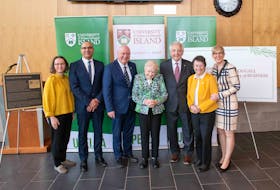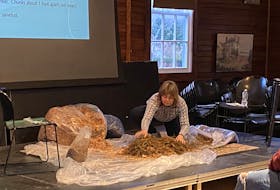WOLFVILLE, N.S. — Going through an entire day without any sort of pain or discomfort comes once in a blue moon.
Joint pain, dry coughs, bee stings, indigestion, you name it, odds are you’ll run into one of those throughout your day. We’ve become accustomed to swallowing a few pills to numb the sensation, but what if the solution was right in your backyard? For herbalist John Cummings, it’s all about knowing where to look.
It’s no mystery that plants possess powerful medicinal properties. In fact, just 150 years ago every living being on the planet was using plants to cure their ailments. As citizens of a developed nation, we have the convenience of modern medicine - we don’t need to rely on plants as our go-to curative, but just because we don’t need to doesn’t mean we shouldn’t.
Cummings has been studying the medicinal properties of plants for over a decade. He has a 25-acre farm on Gaspereau Mountain where he grows and sells herbal medicine. He frequents at the Harriet Irving Botanical Gardens, which is where he led a guided walk on July 25.
The hour-long discussion explored the actions that different plants have and the benefits of using herbal medicine to treat illness. The event is one of many of the Daytime Firefly sessions at the gardens, promoting self-wellness and community engagement.
A group of about a dozen people gathered at the front gates of the Harriet Irving Botanical Gardens around noon, and for the next hour, Cummings had everyone’s undivided attention. He began the afternoon with an explanation of what it means for a plant to possess certain actions.
“Instead of saying that this plant is good for these specific ailments, I like to say that this plant has these actions,” says Cummings. “When I say ‘actions’ I mean a group of effects that a plant has. For instance, I could say that this plant has a cooling action, or this plant has a soothing action.”
Cummings says that his concept of actions is a completely different way of approaching herbal medicine. It has allowed him to have a more complete understanding of each plant and how its chemistry relates to its actions.
“One thing you’ll learn really quickly is that no plant only has just one action. So for example, it’s limiting to say that plant ‘A’ is good for stopping bleeding. I see it as plant ‘A’ may be good for stopping bleeding, but it also has these three or four other effects because of the actions it possesses. It’s never a one-to-one correlation between a plant and an illness.”
As the hour passed, Cummings explained different actions of plants and gave some examples of plants that possess these actions. After going through about 10 different actions, it was time to go examine some specimens.
It would take months to discuss every plant in the Harriet Irving Botanical Gardens, but Cummings had the chance to talk about a few of his favourites. The group got to do some gustatory learning when Cummings passed around a leaf of wormwood, telling everyone to put a small piece in their mouth. After a few seconds, everyone had a scrunched-up face and a mouth full of saliva. Cummings laughed, explaining that the plant helps aid in starting the digestive process.
Cummings’s quick wit and his thorough understanding of herbal medicine, tied together with a bright sunny day, made for a wonderful afternoon at Acadia University.
GO ONLINE: To learn more about Cummings’s practice, see www.greenmanbotanicals.com.








